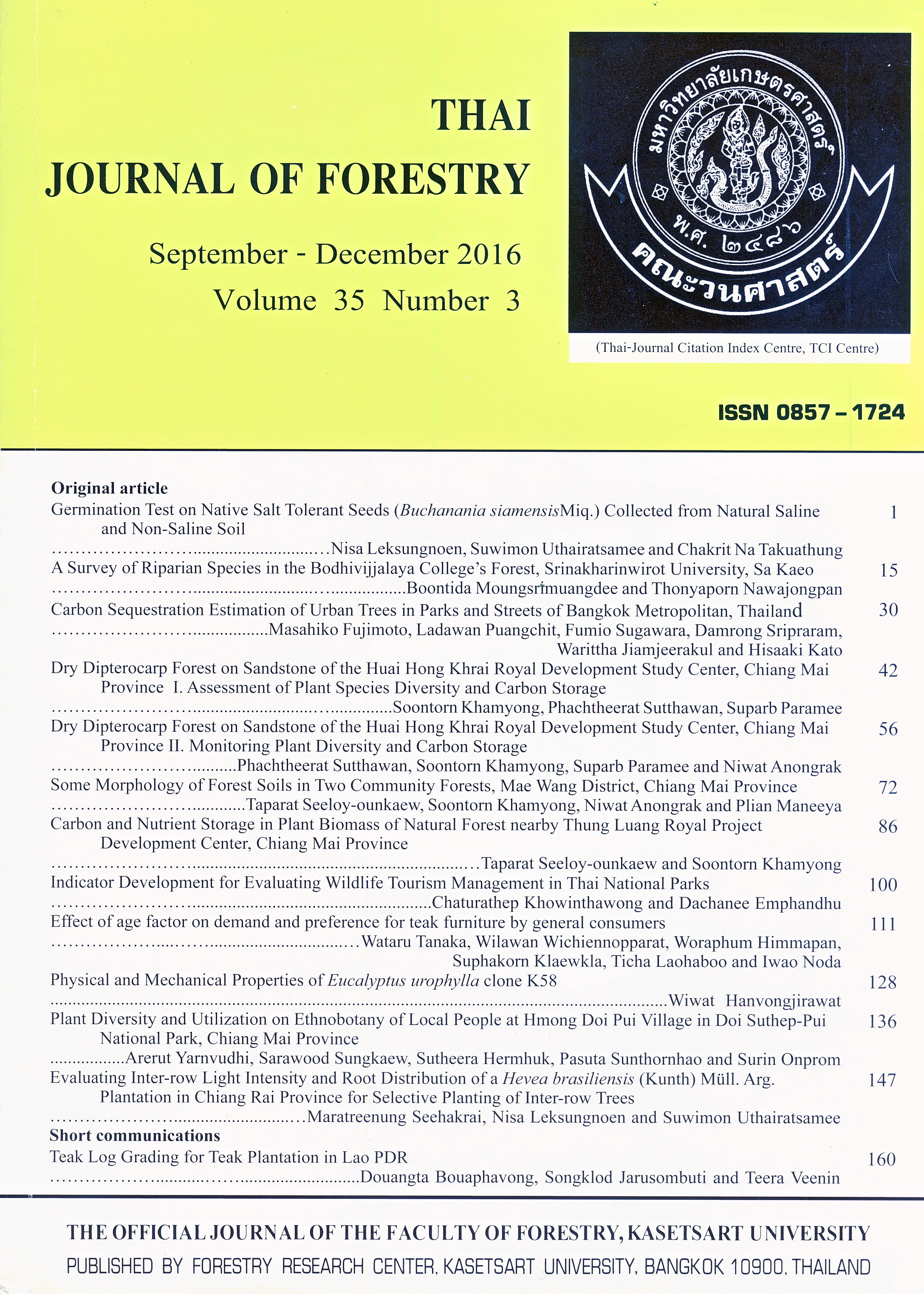Dry Dipterocarp Forest on Sandstone of the Huai Hong Khrai Royal Development Study Center, Chiang Mai Province II. Monitoring Plant Diversity and Carbon Storage
Main Article Content
บทคัดย่อ
Monitoring of plant species diversity and carbon storage in a dry dipterocarp forest (DDF) on sandstone was carried out in 2010 and 2015 at the Huai Hong Khrai Royal Development Study (HHKRDS) Center, Chiang Mai province. The forest was assessed for species diversity and carbon storage in 2010 using 12 permanent plots, each of size 40 × 40 m2, and arranged to randomly sample the forest as reported in Part I. The plant data were obtained by measuring the stem girth over bark at 1.3 m above ground and the height of all trees taller than 1.5 m. Quantitative plant data, plant biomass and carbon amounts derived from the carbon contents in the stem, branch, leaf, and root portions were measured. The DDF was composed of four stands based on the most dominant tree species: Hiang (Dipterocapus obtusifolius), Pluang (D. tuberculatus), Teng (Shorea obtusa) and Rang (S. siamensis). It was found that the species richness, family richness, tree density, and species diversity index (SWI) had decreased from 2010 to 2015 with respective values of 60 to 53 species (-7), 31 to 27 families (-4), 3,865 to 2,780 trees ha-1 (-1,085), and 3.17 to 3.06 (-0.11), respectively. The death of many individual trees in the forest was the main cause of decreasing species diversity and plant production. However, the FCI increased, and the average amount of plant biomass also increased from 83.74 ± 12.35 to 90.65 ± 11.36 Mg ha-1 (+6.91). As a result, the average amount of carbon stored in plant biomass from 2010 to 2015 increased from 41.59 ± 6.26 to 44.79 ± 5.61 Mg ha-1, being a net increase of 3.20 Mg ha-1 (7.7% of the amount in 2010) or only 0.64 Mg ha-1 yr-1.
Downloads
Article Details
ข้าพเจ้าและผู้เขียนร่วม (ถ้ามี) ขอรับรองว่า ต้นฉบับที่เสนอมานี้ยังไม่เคยได้รับการตีพิมพ์และไม่ได้อยู่ในระหว่างกระบวนการพิจารณาตีพิมพ์ลงในวารสารหรือสิ่งตีพิมพ์อื่นใด ข้าพเจ้าและผู้เขียนร่วม (ถ้ามี) ยอมรับหลักเกณฑ์และเงื่อนไขการพิจารณาต้นฉบับ ทั้งยินยอมให้กองบรรณาธิการมีสิทธิ์พิจารณาและตรวจแก้ต้นฉบับได้ตามที่เห็นสมควร พร้อมนี้ขอมอบลิขสิทธิ์ผลงานที่ได้รับการตีพิมพ์ให้แก่วารสารวนศาสตร์ คณะวนศาสตร์ มหาวิทยาลัยเกษตรศาสตร์ กรณีมีการฟ้องร้องเรื่องการละเมิดลิขสิทธิ์เกี่ยวกับภาพ กราฟ ข้อความส่วนใดส่วนหนึ่ง หรือ ข้อคิดเห็นที่ปรากฏในผลงาน ให้เป็นความรับผิดชอบของข้าพเจ้าและผู้เขียนร่วม (ถ้ามี) แต่เพียงฝ่ายเดียว และหากข้าพเจ้าและผู้เขียนร่วม (ถ้ามี) ประสงค์ถอนบทความในระหว่างกระบวนการพิจารณาของทางวารสาร ข้าพเจ้าและผู้เขียนร่วม (ถ้ามี) ยินดีรับผิดชอบค่าใช้จ่ายทั้งหมดที่เกิดขึ้นในกระบวนการพิจารณาบทความนั้น”
เอกสารอ้างอิง
Khamyong, S., N. Anongrak and S. Paramee. 2011. Evaluation of Recovering Forest Ecosystems Through Investigation of Plant Species Diversity, Soil, Watershed and Roles on Carbon-Nutrient Sinks as Reducing Global Warming at Huai Hong Khrai Royal Development Study Center, Chiang Mai Province. Research Report to NRCT.
Krebs, C.J. 1985. Ecology: The experimental analysis of distribution and abundance. Third edition, Harper & Row Publishers, New York, USA.
Ogawa, H., K. Yoda, K. Ogino and T. Kira. 1965. Comparative ecological study on three main types of forest vegetation in Thailand. II. plant biomass. Nature and Life in Southeast Asia 4: 49-80.
Ogino, K., D. Ratanawongs, T. Tsutsumi and T. Shidei. 1967. The primary production of tropical forest in Thailand. The South-east Asian Studies 5 (1): 122-154.
Oliver, C.D. and B.C. Larson. 1996. Forest Stand Dynamics. Updated edition, John Wiley and Sons, Inc. New York, NY, USA.
Pampasit, S. 1995. Ecological study on relationship between plant association in the dry dipterocarp forest and soil properties in the Doi Inthanon National Park, Chiang Mai province. Masters Thesis, Chiang Mai University.
Sahunalu, P. 1994. Production and nutrient circulation of dry dipterocarp forests in Thailand II. Primary productivity and community respiration. Thai J. For. 13: 88-97.
Seeloy-ounkeaw, T., S. Khamyong and K. Sri-ngernyuang. 2014. Variations of plant species diversity along altitude gradient in conservation and utilization community forests at Nong Tao village, Mae Wang district, Chiang Mai province. Thai J. For. 33 (2): 1-18.
Smithinand, T., T. Santisuk and C. Phengklai. 1980. The manual of Dipterocarpaceae of mainland Southeast Asia. Thai For. Bull. 12: 1-110.
Tsutsumi, T., K. Yoda, P. Dhanmanonda and B. Prachaiyo. 1983. Chapter 3. Forest: Felling, burning and regeneration, pp. 13-62. In K. Kyuma and C. Pairintra, eds., Shifting Cultivation: An Experiment at Nam Phrom, Northeast Thailand and Its Implications for Upland Farming in the Monsoon Tropics. A report of a cooperative research between Thai-Japanese University, Kyoto University, Japan.
Waring, R.H. and S.W. Running. 1998. Forest Ecosystems: Analysis at multiple scales. Second edition, Academic Press, San Diego, CA, USA.
Wattanasuksakul, S. 2012. Plant diversity, carbon sinks and nutrient accumulation in ecosystems of dry dipterocarp forest with and without fire at Inthakin Silvicultural Research Station, Chiang Mai province, Ph.D. Thesis, Chiang Mai University.


